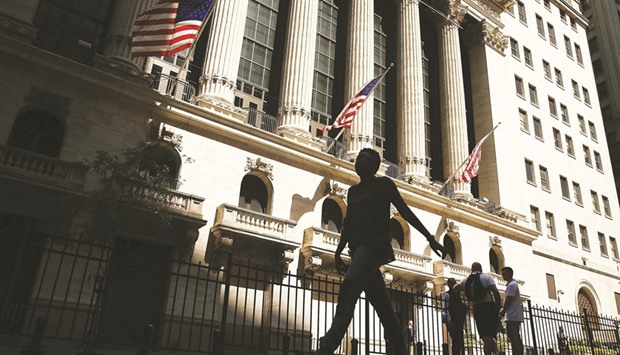While analysts predict net income for S&P 500 Index members fell 1.6% in the July-September period, the expected rate of decline is so small that it will almost certainly evolve into a gain when companies are done beating estimates. For equity bulls, that couldn’t come at a better time, as history shows that breaks in such slumps usually precede some of the stock market’s strongest periods.
The impact of earnings on share prices has never been clearer than in the last 18 months, a stretch in which the annualised return of the S&P 500 plunged to a fraction of the 20% during the bull market’s first six years. The profit recession has been accompanied by three of the biggest eruptions in equity volatility ever recorded, two corrections of 10%, and left valuations at the highest in more than a decade.
“We see a lot commentators talk about the probability of an economic recession increasing for the next year, but we still think we’re more in the mid cycle than late cycle,” said Jon Adams, a portfolio manager at BMO Global Asset Management in Chicago, where the firm oversee $233bn.
The potential for continued economic expansion “supports higher earnings,” he said. On the surface, the third quarter is shaping up as another period of contraction in net income, with analyst estimates turning negative in August and growing progressively more pessimistic in recent weeks. At the same time, US companies have exceeded their forecasts by an average margin of 3.6 percentage points in the past five years. Add that in, and the predicted slide turns into growth after all is said and done.
A snap-back in profit might suggest the weakness in corporate America will be transitory, as opposed to a warning signal about the strength of the overall economy.
While the depth of the earnings recession is shallow, it ranks among the longest in history. Since 1936, S&P 500 profits suffered declines of five quarters or more nine times, with two-thirds associated with economic recessions, data compiled by S&P Dow Jones Indices and Bloomberg show. And out of all 13 economic contractions, only four occurred without a bear market.
For investors looking for evidence the S&P 500 can push the bull market into a ninth year, an end to the profit slowdown bodes well.
Among the nine instances when companies emerged out of prolonged sluggishness, stocks posted gains in all but two.
The S&P 500 rose an average 12% over the following year, compared with an annualised return of 6.3% in the past eight decades. On the three occasions when the earnings contraction wasn’t accompanied by an economic recession, as is the case now, stocks rallied an average 13%.
Strategists remain cautious in their outlook for the S&P 500, which closed on Friday down 0.7% for the week to 2,153.74 – less than 2% below an all-time high. The average of 19 forecasters surveyed by Bloomberg has the index adding less than 1% by the end of this year, while the four that have made projections for next year see a gain of about 8%.
Alcoa kicks off the reporting season today, followed by JPMorgan Chase & Co on Friday. Financial firms in the S&P 500 are projected to do best among 11 groups, with earnings growth of 4% in the third quarter. Stripped of their influence, the profit contraction would reach 2.7%.
Energy producers are the biggest drag on earnings, forecast to see a 67% retreat.
Without them, net income at S&P 500 companies would reach 1.6%, according to data compiled by Bloomberg.
Those figures come before factoring in the consistent ability of chief executive officers at large caps to beat estimates – since 2010, members of the S&P 500 have topped projections by at least 1.6 percentage points in all but two quarters, data compiled by Bloomberg show. If the rate of outperformance holds to the long-term average, the earnings recession will end.
While the bar has been lowered enough for companies to exceed, investors hoping that any acceleration is preordained may be disappointed, according to Julian Emanuel, a strategist at UBS Group. Analysts tracked by Bloomberg project profits to expand 6.3% in the fourth quarter before rising almost 14% in 2017, which is unlikely given economist forecasts for gross domestic product growth of about 2% next year.
“Absent a significant economic acceleration, what investors are likely to be shown in October is lower guidance for 4Q and 2017,” Emanuel wrote in a September 27 note to clients. “Great Expectations should be revised toward a more modest growth trajectory,” he said. “Investors are likely to be left wanting.”
Despite a persistent narrative that it’s been Federal Reserve stimulus alone driving the 7 1/2-year rally in US stocks, one indisputable fact is that a doubling in corporate profits has underpinned the second-longest bull market in history. Bolstered by an increase in annual profits from $61 a share in 2008 to a record $120 in 2014, the S&P 500 more than tripled at its sixth anniversary, exceeding the 2007 peak by a third.

People walk by the New York Stock Exchange. While analysts predict net income for S&P 500 Index members fell 1.6% in the July-September period, the expected rate of decline is so small that it will almost certainly evolve into a gain when companies are done beating estimates.


